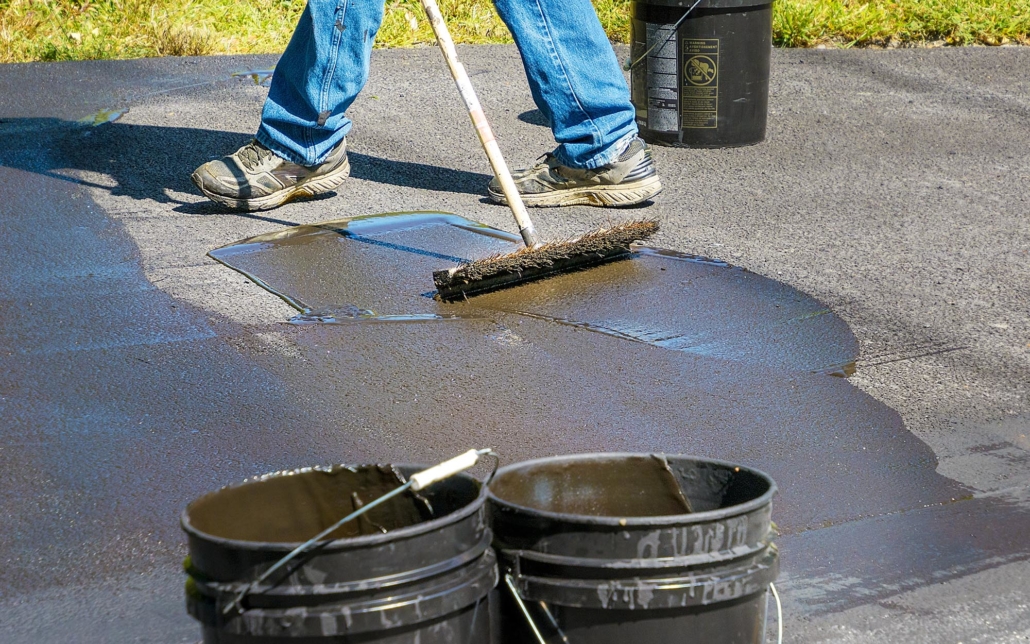Mastering Tilted Parking: How Asphalt Sealing Enhances Industrial Lots
Wiki Article
Hot Mix Asphalt: A Lasting Service for Sidewalk
Warm Mix Asphalt (HMA) has emerged as a leading sustainable choice for sidewalk solutions, using a myriad of innovative modern technologies and environmental advantages. As the demand for eco-friendly building and construction practices grows, exploring the subtleties of HMA's sustainability can give important insights into the future of sidewalk solutions.Ecological Advantages of Warm Mix Asphalt

In Addition, Warm Mix Asphalt helps to minimize city warmth island impacts. Its dark shade soaks up sunlight, decreasing the quantity of warm showed back right into the atmosphere contrasted to lighter-colored sidewalks. This can reduce ambient temperature levels in metropolitan areas, lowering the demand for air conditioning and ultimately decreasing power intake.
Furthermore, Warm Mix Asphalt adds to boosted stormwater administration. Its permeable nature enables water to recharge and penetrate the pavement groundwater supplies, lowering runoff and the risk of flooding. These environmental advantages make Warm Mix Asphalt a sustainable choice for paving highways and roads.
Power Efficiency in HMA Manufacturing
Is energy performance an essential aspect in the production of Hot Mix Asphalt (HMA)? Power plays a substantial role in the manufacturing of HMA, impacting both expense and environmental sustainability. One crucial facet of energy performance in HMA production is the usage of cozy mix asphalt (WMA) innovations.Furthermore, advancements in plant innovations have led to even more energy-efficient HMA production procedures. By optimizing energy usage in HMA production, the industry can minimize its carbon impact while preserving premium sidewalk materials.
Recyclability of Warm Mix Asphalt
The recyclability of Warm Mix Asphalt (HMA) is an essential facet of its sustainability and long-term ecological effect. HMA is one of the most recycled materials in the United States, with over 100 million heaps of recovered asphalt pavement (RAP) being reused every year in new pavement construction. Reusing HMA uses several environmental advantages, such as lowering the need for virgin products, lowering power intake during production, and decreasing the amount of waste sent out to garbage dumps.The process of reusing HMA entails grating the existing sidewalk, squashing it into smaller items, and mixing it with new aggregate and asphalt binder to develop a recycled mix. Generally, the recyclability of HMA plays a substantial duty in promoting lasting practices within the sidewalk sector.

Long-Term Performance of HMA
Asphalt sidewalks demonstrate longevity and durability over an extensive period, reflecting the long-term efficiency of Warm Mix Asphalt (HMA) The longevity of HMA can be credited to its capability to hold up against hefty website traffic loads, rough climate condition, and the results of aging. Research studies have actually revealed that well-designed and effectively constructed HMA pavements can last for 20 years or even more with routine maintenance. The secret to making the most of the long-lasting efficiency of HMA hinges on using top notch materials, adhering to ideal methods in building, and executing efficient maintenance strategies. Appropriate water drainage, routine inspections, and timely fixings are necessary for protecting the architectural integrity of HMA pavements gradually. Additionally, innovations in HMA innovation, such as using polymer-modified binders and cozy mix asphalt, have actually better enhanced the durability and longevity of HMA pavements. By focusing on top quality building and construction and upkeep methods, HMA continues to show itself as a affordable and sustainable remedy for long-lasting pavement framework.
HMA: Toughness and Sustainability
Showing both sturdiness and sustainability, Warm Mix Asphalt (HMA) has ended up being a keystone in the building of long-lasting pavement facilities - regrading. HMA's durability originates from its capacity to stand up to hefty lots, harsh climate condition, and high website traffic volumes, making it a trusted option for roadways, highways, and airport runways. The composition of HMA, which generally consists of accumulations, binder, and filler, plays a vital function in boosting its long life and resistance to damage
Moreover, HMA's sustainability exists in its recyclability and energy-efficient production procedure. The capacity to recycle redeemed asphalt pavement (RAP) in new HMA blends decreases the need for virgin products and lessens the environmental influence of sidewalk building and upkeep. In addition, the energy efficiency of producing HMA lies in its lower mixing temperature levels contrasted to other sidewalk materials, resulting in decreased power consumption and greenhouse gas exhausts.
Verdict
In conclusion, hot mix asphalt (HMA) offers a sustainable remedy for pavement with its eco friendly features. HMA's recyclability, energy performance in manufacturing, and long-lasting toughness make it an environmentally friendly option for roadway building and construction.
HMA is one of the most recycled products in the United States, with over 100 million heaps of reclaimed asphalt pavement (RAP) being recycled annually in brand-new sidewalk building and construction.The process of reusing HMA entails milling the existing pavement, squashing it right into smaller sized pieces, and blending it with brand-new accumulation and asphalt binder to develop a recycled mix.Asphalt commercial parking lot paving sidewalks show resilience and resilience over an extensive period, showing the lasting efficiency of Warm Mix Asphalt (HMA) Additionally, innovations in HMA innovation, such as the usage of polymer-modified binders and cozy mix asphalt, have better improved the longevity and long life of HMA pavements. The capability to reuse reclaimed asphalt sidewalk (RAP) in new HMA mixtures reduces the need for virgin products and minimizes the ecological impact of sidewalk construction and maintenance.
Report this wiki page